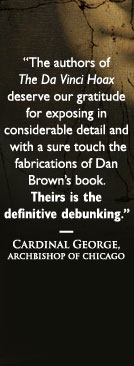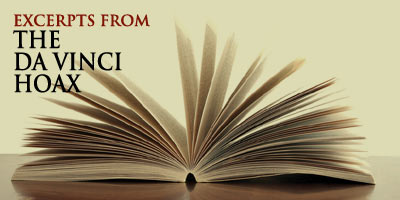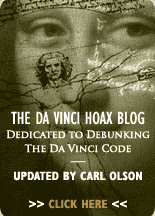



INTRODUCTION
The Da Vinci Code is an anomaly of recent publishing history, in that mere “thrillers” seldom rank at the very top of the best-seller lists, much less are they solemnly discussed by supposedly serious people. When such occurs, there is more going on than meets the eye, but at the same time, where Dan Brown’s The Da Vinci Code is concerned, there is also a great deal less than meets the eye, as Carl E. Olson and Sandra Miesel show so effectively in this book.
Most of the publishing industry is now driven by the balance sheet in ways which, at least according to legend, were not true a generation ago, when major commercial publishers were eager to publish books by serious authors, even if sales did not justify it. Whether those same publishers rejected potential best-sellers because they did not agree with them, is less clear.
In the atmosphere of contemporary publishing, The Da Vinci Code justifies itself solely on the basis of sales. But if Doubleday’s motives are partly cynical (“the book will sell; who cares whether it’s a lot nonsense”), in another sense it is a very serious books, as the publishers no doubt also realize, since it is nothing less than an attack on the very foundations of historical Christianity, an attack which would be little noticed if it were presented in the form of a historical or theological treatise. (Not very many years ago Doubleday, in its Image Books, brought out a series of Catholic works of the highest quality, something which today would be unthinkable.)
People who do not read serious books are reading The Da Vinci Code, and for many it is the closest to a “real” book they will ever come. There is an odd assumption, detectable even among some professed Christians, that Dan Brown’s book would not have been published, would not have become a best-seller, if it were not true. In speaking about the book to Catholic audiences I have found that there are people who, if they cannot deny that it is a work of fiction, are nonetheless unwilling to concede that it is not reliable as history. Such people latch onto peripheral items (“isn’t it true that Opus Dei owns a big building in New York?”) and use those things to “prove” the accuracy of the entire fantastic plot.
For many people today, including some professed Christians, the Good News is bad news. At one time Christians found deeply troubling the claim that the Bible was unreliable history, and if they accepted the claim they did so with heavy heart. But today some church-members would be troubled if presented with incontrovertible evidence that the Scriptures are historically accurate, because such a revelation would require them to rethink their entire relationship to their faith. Paradoxically, many people who might be thought of as unusually active church-members, the kind who frequent Bible-study groups, workshops, and adult-education classes, often seem to do so precisely because they have, as St. Paul warned, “itching ears”. They yearn to hear novelty. They rejoice to have sacred truths “deconstructed”. Thus there are parish groups which have made The Da Vinci Code the subject of their study, treating it with more credulity than they ordinarily give to the Bible itself.
For two hundred years the primary Western assault on Christianity was the rationalism of the Enlightenment, the claim that traditional religion was simply a set of fairy stories believed by the gullible in the face of growing evidence to the contrary. Because of this critique, until fairly recently it seemed necessary to choose between religious faith and a rather sterile rationalism.
But the “counter-culture” of the 1960s inevitably discovered “spirituality”, which is now touted even in the business world. Prosperous people in the advanced Western countries cannot deny themselves anything, and at some point it occurs to them that religious believers are “enjoying” something which the secularists had denied themselves.
But the historical forms of Christianity stand in the way of this new spirituality. Creeds require individuals to rise above themselves, to submit to a truth much greater than themselves, to become real disciples. By contrast, contemporary New Age religion is simply the worship of the self, or at best the worship of deities which the self has created. (How many New Agers really believe in goddesses?)
The moral implications of this are also obvious. The “sexual revolution” is the single most formidable dividing line between the culture and serious Christians. But if religion is a human invention, there cannot be an objective moral law, and all things are permitted. In an often unrecognized way, the passion which drives debates about The Da Vinci Code has more to do with abortion and homosexuality than it does with the origins of Christianity. New Age religiosity invites people to make up their own deities, and The Da Vinci Code invites them to invent their own history, to replace the Gospel of Jesus Christ with scriptures which cater to contemporary preoccupations like feminism.
Christianity makes fundamental historical claims about itself—that, if Jesus did not live, die, and rise again as the Gospels announce, our faith is in vain. This is a daring claim that makes Christianity vulnerable to attack precisely through its history, and Brown invites the reader to see Christianity as nothing less than a gigantic fraud perpetrated over 2000 years, a conspiracy of power which long held a monopoly on the things of the soul and is now being exposed. Shallow though the book is, it is a major weapon in the campaign to discredit the Christian faith once and for all.
The purported scholarly roots of this attack lie in the Gnostic Gospels, which, although written later than the New Testament, are often treated as more reliable than the New Testament. Elaine Pagels, who has done the most to promote the Gnostic Gospels, is quite candid about her own agenda—“spirituality” freed from the constraints of creeds.
If Brown offered his arguments in the form of a historical treatise, they would be dismissed as sheer fantastic speculation. Both he and his publisher are dishonest in that they invite the public to accept the book as history, then, if challenged, retreat to saying “but it’s just a story”. It is another example of a pernicious genre now practiced by, for example, the film-maker Oliver Stone and the novelist Gore Vidal - exploiting the public’s ignorance of history by serving up mixtures of fact and fiction and failing to delineate between the two, scoring points through fiction that could not be made with fact. It is more than ironic that so much obloquy is now being heaped on Mel Gibson’s The Passion of the Christ, which is based almost entirely on the New Testament, while many of the people who excoriate the film see nothing wrong with The DaVinci Code.
Carl E. Olson and Sandra Miesel have done a superb and meticulous job of dissecting the fraud which is The Da Vinci Code. Not only Christians but all fair-minded people owe them a debt of gratitude.
—James Hitchcock, Ph.D.
Department of History
St. Louis University
WANT TO READ MORE? ORDER THE DA VINCI HOAX NOW! CLICK HERE

